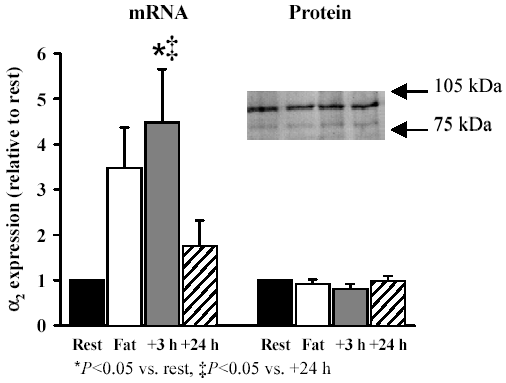
The Na+,K+-ATPase comprises a catalytic α subunit (∼100-112kDa) and a glycosylated β subunit (~40-60kDa), and belongs to a multi-gene family, with different genes encoding for four α (α1, α2, α3, α4) and three β isoforms (β1, β2, β3). Characterisation of the Na+,K+-ATPase isoforms expressed in healthy human skeletal muscle, and consequently also the acute exercise effects on these isoforms remains incomplete. We therefore investigated Na+,K+-ATPase isoform expression in human skeletal muscle, and the effects of a single bout of intense exercise on the mRNA and protein expression of these isoforms.
Fifteen healthy subjects (eight males, seven females) performed a single bout of isokinetic one-legged knee extensor exercise, continued until fatigue (time to fatigue 352 ± 69 s; mean ± SD). A vastus lateralis muscle biopsy was taken from each subject at rest, fatigue (Fat), 3 h (+3 h) and 24 h (+24 h) post-exercise and analysed for mRNA and protein expression using Real-Time RT-PCR and immunoblotting, respectively. The Na+,K+-ATPase isoforms probed were α1, α2, α3, β1, β2 and β3. To ensure maximal recovery of Na+,K+-ATPase enzymes, all immunoblots were conducted on crude muscle homogenates.
Muscle from each individual expressed gene transcripts and protein bands for each of the Na+,K+-ATPase α1, α2, α3, β1, β2 and β3 isoforms. These were also expressed in a skeletal muscle cell culture. Exercise immediately increased α3 and β2 mRNA expression (P<0.05), whereas upregulation of α1 and α2 (see the Figure) isoform mRNA (P<0.05) occurred at 24 h and 3 h post-exercise, respectively. Although significant differences between times were not found for β1 and β3 mRNA due to variable time-dependent responses, the peak post-exercise mRNA expression of these isoforms was elevated (P<0.05). In contrast to the dramatic mRNA upregulation, exercise had no significant effect on the crude muscle homogenate protein expression of any of the α1-α3 and β1-β3 isoforms.

In conclusion, the vastus lateralis muscle from healthy humans expresses each of the Na+,K+-ATPase α1-α3 and β1-β3 isoforms at both the transcription and protein levels. Further, only 6 min of exercise was sufficient to dramatically increase the mRNA expression of each of these six isoforms. In contrast, this exercise bout had no effect on isoform protein expression, suggesting this was an insufficient stimulus for Na+,K+-ATPase upregulation in muscle. These findings indicate different transcriptional and post-transcriptional Na+,K+-ATPase regulation with exercise in human skeletal muscle.